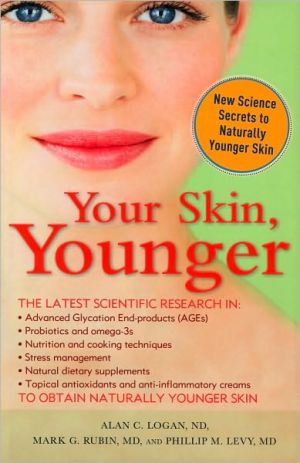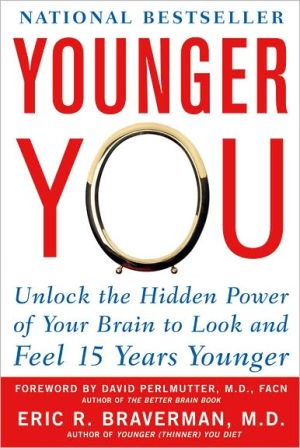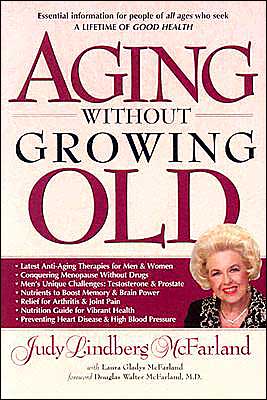Your Skin, Younger: New Science Secrets to Naturally Younger Skin
The Easiest Action Plan for Naturally Younger Skin\ The glowing, wrinkle-free complexion you've always dreamed of is within your reach. You can prevent and limit the visible signs of aging—without synthetics, cosmetics, Botox, or surgery. Based on the latest scientific research, Your Skin, Younger shows you how nutritional skin care will make your skin radiant, healthy, and age-defiant.\ Unlike other books or websites, Your Skin, Younger offers affordable, accessible ways to achieve...
Search in google:
Your Skin, Younger presents clear, scientific evidence of the skin's aging process and how it is directly impacted by diet, stress, intestinal function, and even cooking techniques. Written by top dermatology and nutrition experts, the book reveals what you can do—naturally—to reverse bad effects for nourished, younger-looking skin. Library Journal These two titles take drastically different approaches to skin care. Naturopathic physician Logan, Mark G. Rubin, M.D. (dermatology, Univ. of California-San Diego), and Phillip M. Levy, M.D., who specializes in internal medicine and dermatology, discuss the scientific advances in preventing, slowing, and, to a certain degree, reversing skin damage. Nikogosian, a well-known celebrity skin care expert in Los Angeles, approaches skin care with special recipes for toners, moisturizers, and toning creams made at home from botanicals. VERDICTYour Skin is much more technical and may be a bit heavy at times for lay readers, but it is authoritative and presents an excellent overview of current thought. It will be of more use for most library collections than Nikogosian's personal take. Her recipes, even the most complicated, reflect a "handed down from mother to daughter" attitude and will appeal to readers who gravitate toward natural procedures and products.—Susan B. Hagloch, formerly with Tuscarawas Cty. P.L., New Philadelphia, OH
Excerpt from Chapter One\ Sun exposure is a major contributor to the visible signs of aging. That's common knowledge. Outside of this fact, however, most adults—even doctors—write off youthful-looking skin as a simple matter of genetics. The assumption is that fine lines,\ wrinkles, dullness, furrows, sagging, uneven tone, roughness, and scaling are a matter of the cards that have been dealt from the genetic deck. Many people think that these visible signs of skin aging should be accepted as a foregone conclusion, that we should just sit idly by and watch them unfold in the mirror as a "normal" part of the aging process. But that's not true.\ Nutrition, stressors, mental outlook, lifestyle habits, and other environmental factors all play a role in the visible signs of aging. Genetics are far from the whole story, and much can be done from a nutritional standpoint, both internally and topically, to combat and prevent the aging processes in human skin. Visible signs of aging should not be dismissed as benign. In addition to the tremendous psychological fallout, a growing body of science demonstrates that facial wrinkles are a reliable surrogate marker of internal health.\ Using nutrition and lifestyle approaches, we will help you complement the outstanding technological advances used in dermatology clinics and promote health from the inside out. Cutting-edge techniques of cosmetic dermatology provide an incredible service to patients who want to undo the hands of time. The satisfaction rating of those who seek dermatological care for nonsurgical cosmetic medicine is extremely high. The advances in technology and sophistication of treatments have translated into meaningful visual results, which in turn translate into improved self-esteem and quality of life.\ Much has been written on advances in laser techniques, microdermabrasion, botox injections, and injectable fillers, to name a few. Countless books and articles describe the anti-aging advantages of modern dermatological care. Here we will take a different approach, one that takes us back to the future in dermatology. Some sixty or seventy years ago, great emphasis was placed on the effect of nutrition and lifestyle on the health and appearance of skin. There was an inside-out approach to healthy skin. As the scientific sophistication of dermatology shifted into high gear in the 1960s, many of the older teachings were, as one dermatologist put it, "thrown into the dustbin of history." The focus shifted almost exclusively to synthetic topical preparations and light-based technology. Nutrition had no place in this new paradigm and was quickly relegated to the stuff of home economics class. Yet today, research has validated many of the teachings of our dermatology elders, and nutrition and lifestyle are back in scientific vogue. In addition to radiant, glowing skin with diminished signs of aging, many collateral health benefits come with consideration of diet and stress management. As you work your way through these chapters, you will be armed with the knowledge to boldly resist the opposing forces of skin aging.\ Holding Us Together\ Everything in your body is contained, or held in, by a tremendous organ with great sophistication, durability, and resiliency—your skin. Many of us take the skin for granted. When we think of a human organ, we tend to think of the brain, heart, kidneys, or lungs. Rarely do we sit back and appreciate our skin as a living, breathing, and dynamic organ. It is our largest organ: spread out, it covers some 20 square feet, and it makes up one-sixth of average body weight. But skin just doesn't get the respect it deserves.\ Over the course of a lifetime, our skin will do so much for us, not the least of which is its service as the great defender against the assaults of the outside world. It is also involved in fluid and temperature control, immune system surveillance, vitamin D formation, and the transfer of sensory information.\ It is our organ of emotional expression; facial skin allows the visual display of all our deepest emotions. You can think of your skin as a brave soldier on the front lines, protecting you from all conceivable physical, chemical, and environmental assaults.\ How do we repay this brave soldier for its acts of valor? Do we care for the skin and provide it with all of the raw materials for optimal functioning? What type of rations and nourishment do we provide? What type of rest from stress is provided? Do we place the skin in harm's way more often than need be? Do we damage the skin with dangerous synthetic chemicals purported to help skin structure and function? The answers to all of these questions will determine the true "age" of your skin, a numerical value quite distinct from your chronological age.\ High-quality human nutrition provides all the raw materials necessary for both structure and functioning of the skin, and a steady stream of optimal nutrients go a long way in supporting healthy skin over the course of a lifetime. Nutrient deficiencies, on the other hand, can compromise skin health, and dietary excesses in the form of sugar and harmful fast food can directly damage skin structure and function.\ Anatomy\ Before considering aging skin's structural and physiological changes and how to limit the aging process, we must first look at the components of normal skin.\ Epidermis: The Outer Layer\ The outer layer of the skin, the part we actually see, is the epidermis. Although very thin, usually only half a millimeter, depending on location, the epidermis contains the important components on the next page. Renewing the epidermis takes about four weeks in normal skin. As we age, this turnaround time increases by as much as 50 percent, while the demand for nutrients becomes even more important.\ • Stratum Corneum: Set up like bricks and mortar, this layer within the epidermis is critical for moist, well-hydrated skin. The stratum corneum is made up of keratin (bricks) and intercellular lipid complex (mortar).\ • Ceramides: These are fat- (or lipid-) based chemicals within the stratum corneum. Some cosmetics mimic these ceramides, since they maintain the skin barrier.\ • Keratin: This tough protein provides flexibility, chemical resistance, and protection. It is made up of nutrients such as amino acids, carbohydrates, and fatty acids.\ • Basal Layer: Located at the bottom of the epidermis, this layer creates cells that form keratin.\ • Melanocytes: These cells in the basal layer produce melanin, our skin pigment.\ • Langerhans Cells: These cells perform immune system surveillance.
Introduction xi1 Inside Out: The Renewed Science of Dermatology 12 Inflammation and Oxidative Stress: The Flames of Skin Aging 293 Sugar and the AGEing Skin 594 Skin Digestion: The Gut-Skin Connection 815 The Brain-Skin Connection and Your Beauty Sleep 1056 Skin Food I: Dietary Supplements 1437 Skin Food II: Natural Topicals 1758 Dietary Plan of Action and Recipes 2159 Concluding Remarks 237AppendicesResources 245References 253Index 289About the Authors 301
\ Library JournalThese two titles take drastically different approaches to skin care. Naturopathic physician Logan, Mark G. Rubin, M.D. (dermatology, Univ. of California-San Diego), and Phillip M. Levy, M.D., who specializes in internal medicine and dermatology, discuss the scientific advances in preventing, slowing, and, to a certain degree, reversing skin damage. Nikogosian, a well-known celebrity skin care expert in Los Angeles, approaches skin care with special recipes for toners, moisturizers, and toning creams made at home from botanicals. VERDICTYour Skin is much more technical and may be a bit heavy at times for lay readers, but it is authoritative and presents an excellent overview of current thought. It will be of more use for most library collections than Nikogosian's personal take. Her recipes, even the most complicated, reflect a "handed down from mother to daughter" attitude and will appeal to readers who gravitate toward natural procedures and products.—Susan B. Hagloch, formerly with Tuscarawas Cty. P.L., New Philadelphia, OH\ \







